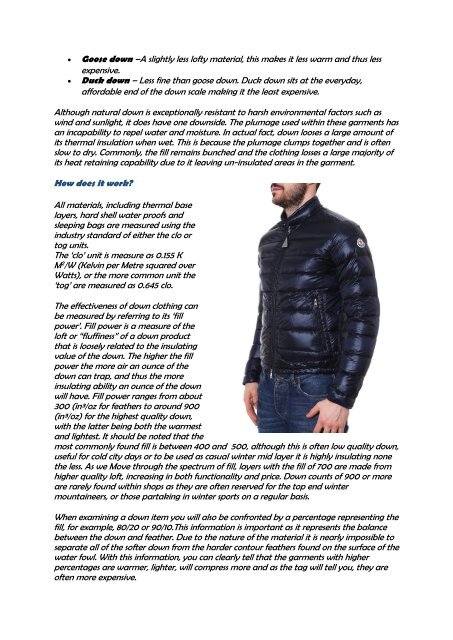Moncler down jacket best buy offer today
Review down jacket for men with best offer to buy today
Review down jacket for men with best offer to buy today
You also want an ePaper? Increase the reach of your titles
YUMPU automatically turns print PDFs into web optimized ePapers that Google loves.
Goose <strong>down</strong> –A slightly less lofty material, this makes it less warm and thus less<br />
expensive.<br />
Duck <strong>down</strong> – Less fine than goose <strong>down</strong>. Duck <strong>down</strong> sits at the everyday,<br />
affordable end of the <strong>down</strong> scale making it the least expensive.<br />
Although natural <strong>down</strong> is exceptionally resistant to harsh environmental factors such as<br />
wind and sunlight, it does have one <strong>down</strong>side. The plumage used within these garments has<br />
an incapability to repel water and moisture. In actual fact, <strong>down</strong> looses a large amount of<br />
its thermal insulation when wet. This is because the plumage clumps together and is often<br />
slow to dry. Commonly, the fill remains bunched and the clothing losses a large majority of<br />
its heat retaining capability due to it leaving un-insulated areas in the garment.<br />
How does it work?<br />
All materials, including thermal base<br />
layers, hard shell water proofs and<br />
sleeping bags are measured using the<br />
industry standard of either the clo or<br />
tog units.<br />
The ‘clo’ unit is measure as 0.155 K<br />
M 2 /W (Kelvin per Metre squared over<br />
Watts), or the more common unit the<br />
‘tog’ are measured as 0.645 clo.<br />
The effectiveness of <strong>down</strong> clothing can<br />
be measured by referring to its ‘fill<br />
power’. Fill power is a measure of the<br />
loft or “fluffiness” of a <strong>down</strong> product<br />
that is loosely related to the insulating<br />
value of the <strong>down</strong>. The higher the fill<br />
power the more air an ounce of the<br />
<strong>down</strong> can trap, and thus the more<br />
insulating ability an ounce of the <strong>down</strong><br />
will have. Fill power ranges from about<br />
300 (in³/oz for feathers to around 900<br />
(in³/oz) for the highest quality <strong>down</strong>,<br />
with the latter being both the warmest<br />
and lightest. It should be noted that the<br />
most commonly found fill is between 400 and 500, although this is often low quality <strong>down</strong>,<br />
useful for cold city days or to be used as casual winter mid layer it is highly insulating none<br />
the less. As we Move through the spectrum of fill, layers with the fill of 700 are made from<br />
higher quality loft, increasing in both functionality and price. Down counts of 900 or more<br />
are rarely found within shops as they are often reserved for the top end winter<br />
mountaineers, or those partaking in winter sports on a regular basis.<br />
When examining a <strong>down</strong> item you will also be confronted by a percentage representing the<br />
fill, for example, 80/20 or 90/10.This information is important as it represents the balance<br />
between the <strong>down</strong> and feather. Due to the nature of the material it is nearly impossible to<br />
separate all of the softer <strong>down</strong> from the harder contour feathers found on the surface of the<br />
water fowl. With this information, you can clearly tell that the garments with higher<br />
percentages are warmer, lighter, will compress more and as the tag will tell you, they are<br />
often more expensive.


